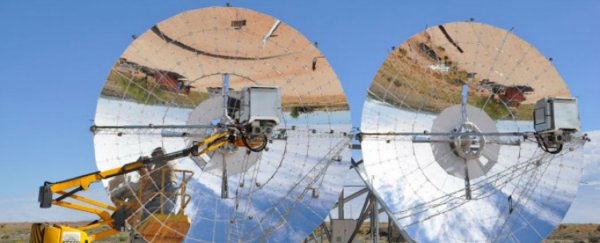A Swedish technology company has installed a new solar electricity generation system in South Africa's sun-soaked Kalahari desert, saying it's not only the most efficient system of its kind in the world, but it doubles the efficiency of standard solar panels.
The system, which features a pair of huge, 12-metre mirror dishes, runs on a Stirling engine - a type of closed-cycle regenerative heat engine that was invented way back in 1816, and uses trapped gas instead of water to propel the internal pistons and flywheel. The dishes are slowly rotated throughout the day to capture the maximum amount of solar rays and focus them into a specific point, which kicks the Stirling engine into gear.
Adopted by the Swedish military for use in their submarines almost three decades ago, Stirling engines have since been touted as the perfect match for renewable energy systems because they can function with almost any heat source, are quiet to run, and don't take up much space. Swedish-based company, Ripasso Energy, licensed the technology from the military, and together with their colossal parabolic mirror dishes, the system requires just 2 hectares to produce a megawatt of energy.
The researchers at Ripasso have been testing the system for the past four years, and hope that by basing it in the desert, they can get the best idea of its efficiency potential. And as of this week, they claim to have set a new world record. Jeffrey Barbee reports for The Guardian:
"This is the only working small-scale concentrated solar energy system of its kind in the world. Thirty-four percent of the Sun's energy hitting the mirrors is converted directly to grid-available electric power, compared to roughly half that for standard solar panels. Traditional photovoltaic panels are able to turn about 23 percent of the solar energy that strikes them into electricity, but this is cut to around 15 percent before it is usable by the grid."
In November 2012, the same technology set a record-breaking 32 percent efficiency rating.
The Guardian reports that independent tests have confirmed the system's capacity to generate 75 to 85 megawatt hours of electricity a year, which would cover the electricity needs of 24 average UK homes, and would save approximately 81 tonnes of carbon dioxide being released into the atmosphere via coal burning.
The challenge now is to show the potential of the system in environments where sunlight isn't as abundant. It's all very well for a solar system to work brilliantly in the middle of a desert, but it needs to be able to work in an urban environment in order to make an actual difference. But this team is no stranger to setting records using solar technology, so hopefully they'll figure it out.
H/T: The Guardian
